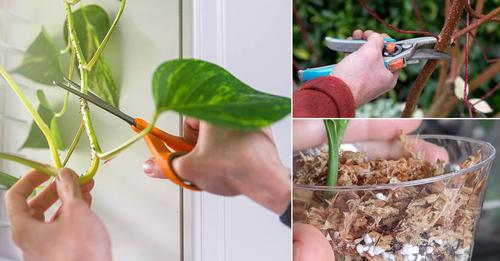Here are the Most Common Mistakes While Propagating Plants from Cuttings that you need to avoid at all costs for a better success rate.
Most Common Mistakes While Propagating Plants from Cuttings
#1 – Taking Cuttings at Any Time of the Year

Propagation at any time of year can not have positive results always. Different plants need different seasons. For example, some specimens root best from cuttings in winter when dormant, while others do best in spring.
Always do your research on the internet about the specific plant to get the best results.

Do not take the cutting at any random part of the day, as it might do more harm than good. Always take cuttings in the morning when the nutrient circulation is at its peak, which means the cutting will be power-packed when you snip it, thus boosting growth.
#3 – Not Cleaning the Tools

Before snipping cuttings, use clean tools as they might have dirt and pathogens on them, which can transfer fungal issues.
- It is always good to use a clean scissor or shear for snipping purposes.
- Avoid using tools having rust on them.
- If you use old shear or scissors, always wash them with a soap solution. It is particularly important if you have used them to prune rotten or diseased parts of some plants. You can also sanitize them with bleach or rubbing alcohol.
#4 – Snipping the Wrong Part of the Plant
While taking cuttings, it is important to cut them correctly. Most plants root best when the cuttings are taken from the stem base. Each plant is unique in how it can be propagated.
For flowering plants, ensure to snip away the blossom and buds as the cutting will use all its energy to save the bloom, reducing the chances of successful propagation.
Also, you must snip the cutting right below the node. It is a site of great cellular activity and growth.
#5 – Not Understanding the Types of Cuttings

Before you take the cuttings, it is important that you understand their types:
- Softwood Cuttings: As the name suggests, these are the soft and new growth of woody plants right before they start to harden (mature). Petunia, thyme, basil, and verbena are the best examples.
- Semi-Hardwood Cuttings: These are partially mature stems, and many broadleaf evergreen shrubs are propagated using these cuttings. Jasmine, English ivy, and holly reproduce the best from it.
- Hardwood Cuttings: These are mature stems of old growth that are firm and do not bend easily. Hardwood cuttings are used most often for deciduous shrubs. Fig, rose, and hydrangea are the best examples.
#6 – Snipping off Too Much

While growing plants from cuttings, people have a misconception that the longer the length of the cutting, the more successful the propagation will be–which is a myth.
Most plant cuttings root best when they are under 4 inches. You can go to a max of 5-6 inches, but avoid snipping more than that.
Cuttings longer than 7 inches may stress out while propagation, causing them to wilt and die.
#7 – Choosing the Wrong Growing Medium

No. You cannot scoop out a handful of the garden soil and use it to propagate every plant cutting. It doesn’t work like that.
Every plant cutting has different needs. Some do well in water, some in the light seed mix, while others prefer just peat or sand, and a few thrive in a regular potting mix.
#8 – Not Careful While Watering

Cuttings need constant moisture because they don’t have an established root system to rely on, so the stem relies on itself for this job.
The best rule to follow is to keep the growing medium slightly moist and never let that to be dry completely.
The best way to saturate the growing medium for cuttings is by misting. This will prevent disturbance, which might happen due to the pouring of water.
If you are growing cuttings in water, make sure to change that every 3 to 5 days.
#9 – Be Careful with Light Requirements

While growing plants from cuttings, it is essential that you expose them to bright and indirect light for most of the day. Avoid keeping the cuttings in complete shade or dark areas. Also, do not expose them to the direct harsh afternoon sun.
#10 – Not Letting Succulent Leaves Callus

Another mistake people make is to plant succulents or cacti cuttings (leaf or stem) without allowing the cut end to callus, which means allowing the cut end to heal and dry. It eliminates the chances of rotting and ensures positive propagation.
Callusing takes anywhere between 3 to 7 days; how soon exactly? It mostly depends on the type of climate you live in.
#11 – Not Using Rooting Hormone

According to Michigan State University, using rooting hormone accelerates root initiation, improves rooting uniformity, increases the number of roots produced, and ultimately reduces rooting time.
You can also use honey and aloe vera as natural rooting hormones.

